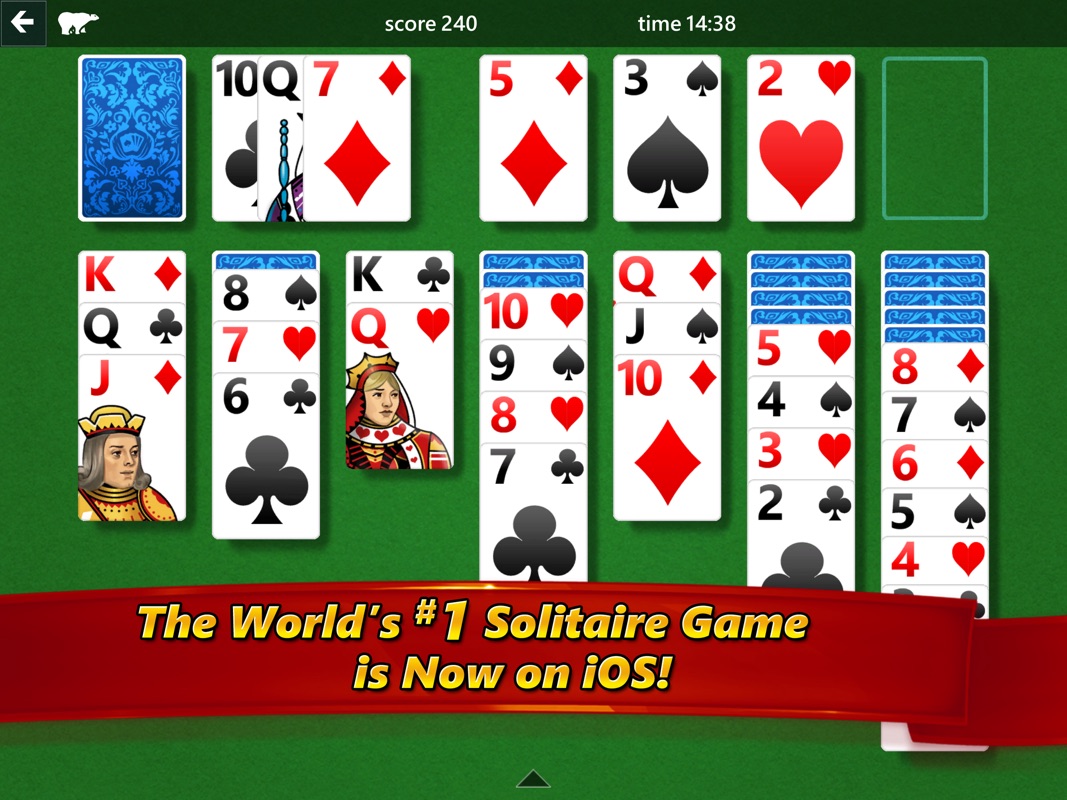Microsoft Solitaire Online
- Microsoft Solitaire online, free Klondike
- Microsoft Solitaire Online Gameplay
- Microsoft Solitaire online, free Klondike Turn One
| Original author(s) | Wes Cherry |
|---|---|
| Developer(s) | Microsoft Casual Games |
| Initial release | May 22, 1990; 30 years ago |
| Operating system | Microsoft Windows |
| Platform | IA-32, x86-64 (and historically DEC Alpha, Itanium, MIPS, and PowerPC) |
| Successor | Microsoft Solitaire Collection (Windows 10) |
Introduction to Solitaire 1 card. Klondike is one of the most-known solitaire card game in the world. In some areas, it's known as American Patience. Often, the game is simply referred to as Solitaire. In this version of Klondike the Stock deals 1 card at a time. The Stock allows for an unlimited number of passes. You must enable JavaScript in your browser settings in order to play this game. News for Microsoft Solitaire Collection.
Solitaire is a computer game included with Microsoft Windows, based on a card game of the same name, also known as Klondike.
History[edit]
Microsoft has included the game as part of its Windows product line since Windows 3.0, starting from 1990.[1] The game was developed in 1988 by the intern Wes Cherry.[2][3][4] The card deck itself was designed by Macintosh pioneer Susan Kare.[5] Cherry's version was to include a boss key that would have switched the game to a fake Microsoft Excel spreadsheet, but he was asked to remove this from the final release.[6]
Microsoft Solitaire online, free Klondike
Microsoft intended Solitaire 'to soothe people intimidated by the operating system,' and at a time where many users were still unfamiliar with graphical user interfaces, it proved useful in familiarizing them with the use of a mouse, such as the drag-and-drop technique required for moving cards.[1]
According to Microsoft telemetry, Solitaire was among the three most-used Windows programs and FreeCell was seventh, ahead of Word and Microsoft Excel.[7][7] Lost business productivity by employees playing Solitaire has become a common concern since it became standard on Microsoft Windows.[8]
In October 2012, along with the release of the Windows 8 operating system, Microsoft released a new version of Solitaire called Microsoft Solitaire Collection.[9] This version, designed by Microsoft Studios and developed by Arkadium, is advertisement supported and introduced many new features to the game.
Microsoft Solitaire celebrated its 25th anniversary on May 18, 2015. To celebrate this event, Microsoft hosted a Solitaire tournament on the Microsoft campus and broadcast the main event on Twitch.[10]
By its 30th anniversary in 2020, it was estimated that the game still had 35 million active monthly players and more than 100 million games played daily, according to Microsoft.[11]
Features[edit]
On winning the game, the player is treated to the cards appearing to fall off each stack and bouncing off the screen.[6] This 'victory' screen is considered a prototypical element that would become popular in casual games, compared to the use of 'Ode to Joy' on winning a level of Peggle, and makes Solitaire one of the first such casual video games.[12][13]
Since Windows 3.0, Solitaire allows selecting the design on the back of the cards, choosing whether one or three cards are drawn from the deck at a time, switching between Vegas scoring and Standard scoring, and disabling scoring entirely. The game can also be timed for additional points if the game is won. There is a cheat that will allow drawing one card at a time when 'draw three' is set.

In Windows 2000 and later versions of Solitaire, right-clicking on open spaces automatically moves available cards to the four foundations in the upper right-hand corner, as in FreeCell. If the mouse pointer is on a card, a right click will move only that card to its foundation, provided that it is a possible move. Left double-clicking will also move the card to the proper foundation.
Microsoft Solitaire Online Gameplay
Until the Windows XP version, the card backs were the original works designed by Susan Kare, and many were animated.
The Windows Vista and Windows 7 versions of the game save statistics on the number and percentage of games won, and allow users to save incomplete games and to choose cards with different face styles.
On Windows 8, Windows 10, Windows Phone, Android, and online the game was issued as Microsoft Solitaire Collection, where in addition to Klondike four other game modes were featured, Spider, FreeCell (both of which had been previously featured in versions of Windows as Microsoft Spider Solitaire and Microsoft FreeCell), Pyramid, and TriPeaks (both of which were previously part of the Microsoft Entertainment Pack series, the former under the name Tut's Tomb).
References[edit]
- ^ abGarreau, Joel (March 9, 1994). 'Office Minefield'. The Washington Post.
- ^Farokhmanesh, Megan (April 13, 2017). 'A bored intern created the original Windows Solitaire'. The Verge. Vox Media.
- ^Cherry, Wes. 'Interview with Wes Cherry - B3TA.com 2008'. B3ta.com. Retrieved August 22, 2014.
- ^'Wes Cherry on Reddit about Solitaire'.
- ^'Susan Kare personal website showing her design for Microsoft Solitaire'. Kare.com. Archived from the original on August 28, 2008. Retrieved August 22, 2014.
- ^ abWarren, Tom (May 22, 2020). 'Microsoft Solitaire turns 30 years old today and still has 35 million monthly players'. The Verge. Retrieved May 24, 2020.
- ^ abDear, Brian (2017). '27. Leaving the Nest'. The Friendly Orange Glow. New York: Pantheon Books. pp. 502–503. ISBN9781101871560.
- ^Church, George J. (October 12, 1998). 'Quarterly Business Report: Do Computers Really Save Money?'. Time. Time Inc.
- ^'Microsoft Solitaire Collection'. App Store. Microsoft.
- ^'Celebrating Microsoft Solitaire'. Blogging Windows. Microsoft. May 18, 2015.
- ^Dent, Steve (May 22, 2020). 'Microsoft's classic Solitaire game is 30 today'. Engadget. Retrieved May 22, 2020.
- ^Trefry, Gregory (2010). Casual Game Design: Designing Play for the Gamer in All of Us. CRC Press. pp. 2–4. ISBN0080959237.
- ^'Casual Gaming Worth $2.25 Billion, and Growing Fast'. October 29, 2007. Retrieved August 11, 2008.